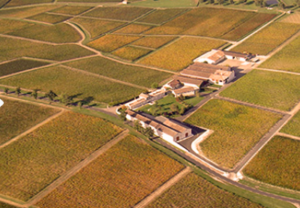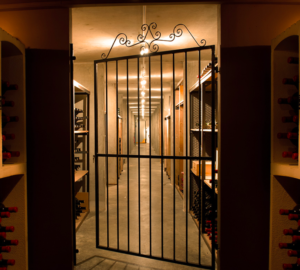
Overview
 Jean Gautreau discovered Sociando-Mallet in the village of Saint-Seurin-de-Cadourne in 1969 when looking for a wine estate to buy on behalf of a Belgian client. It was love at first sight, despite the fact that the property was in a sorry state. However, the terroir was excellent and the domain afforded a magnificent view overlooking the Gironde Estuary. Jean Gautreau immediately decided to acquire it for himself for 250,000 French francs.
Jean Gautreau discovered Sociando-Mallet in the village of Saint-Seurin-de-Cadourne in 1969 when looking for a wine estate to buy on behalf of a Belgian client. It was love at first sight, despite the fact that the property was in a sorry state. However, the terroir was excellent and the domain afforded a magnificent view overlooking the Gironde Estuary. Jean Gautreau immediately decided to acquire it for himself for 250,000 French francs.
There were only 5 hectares of vines at the time. Jean Gautreau expanded the vineyard year after year by buying vines from his neighbours. Seeking the best possible quality, he also renovated the estate’s buildings, built a barrel cellar, and gradually improved the choice of grape varieties, matching the appropriate ones to each vineyard plot.
Today, the property is comprised of 83 hectares producing nearly 450,000 bottles a year of Château Sociando-Mallet and the second wine, Demoiselle de Sociando-Mallet. Jean Gautreau sold his négociant business in 2000 and now focuses entirely on managing his wine estate.
Château Sociando-Mallet is in the commune of Saint-Seurin-de-Cadourne, ten kilometres north of Pauillac, in the Haut-Médoc appellation. A document dating from March 1633 refers to land here belonging to an aristocrat of Basque origin named Sociondo. A member of his family was Bishop of Bayonne. Another document, from 1750 mentions vines belonging to Demoiselle Anne de Sossiondo. Due to various misspellings over the years, “Sossiondo” became “Sociando”.
The Terroir
 Sociando-Mallet has throned on the Butte de Baleyron, one of the finest gravelly terroirs in the Médoc, since the 17th century. Situated in the commune of Saint-Seurin-de-Cadourne, north of Pauillac, the vineyard overlooks the Gironde estuary on a bend in the river.
Sociando-Mallet has throned on the Butte de Baleyron, one of the finest gravelly terroirs in the Médoc, since the 17th century. Situated in the commune of Saint-Seurin-de-Cadourne, north of Pauillac, the vineyard overlooks the Gironde estuary on a bend in the river.
Sociando-Mallet’s terroir consists of Günz gravel over a deep layer of clay-limestone soil. This terroir perfectly regulates water supply and enables Cabernet Sauvignon to ripen extremely well and Merlot to acquire depth and complexity. This terroir is Sociando’s soul. It provides the wine with complex structure, freshness, and elegance.
Primarily located east of the village of Saint-Seurin, the property stretches over a total of 120 hectares, of which 83 are under vine. The vines grow on the superb Baleyron gravelly hillock around the house and winery buildings. Sun exposure is optimum and breezes off the estuary keep the vines well aired and healthy. The huge mass of water in the estuary and nearby ocean accounts for a temperate microclimate without wild swings in temperature. Grape varieties consist of 42% Cabernet Sauvignon, 54% Merlot, and 4% Cabernet Franc. The vines are an average 35 years old. The average vine density is 8,333 vines per hectare. This corresponds to 1 metre between vine rows and a distance of 1.2 metres between plants within a row. This high density increases the surface of the leaf canopy and creates a competition between vines, conducive to the production of grapes with a high content of tannin, sugar, colour and aromas.
The Winemaking Process
 Sociando Mallet is vinified traditionally. Only native yeast and bacteria naturally present on the grapes and at the estate are used. Sociando-Mallet has stainless steel and concrete vats, both of which are temperature-controlled. Once the wine is put into vat, the crushed grapes start to ferment thanks to the presence of yeast. The skins and pips float to the surface and form a cap above the must (fermenting grape juice). The vats are pumped over daily to extract colouring matter and aromas from this cap. Pumping over consists in spraying the cap with must taken from the bottom of the vat.
Sociando Mallet is vinified traditionally. Only native yeast and bacteria naturally present on the grapes and at the estate are used. Sociando-Mallet has stainless steel and concrete vats, both of which are temperature-controlled. Once the wine is put into vat, the crushed grapes start to ferment thanks to the presence of yeast. The skins and pips float to the surface and form a cap above the must (fermenting grape juice). The vats are pumped over daily to extract colouring matter and aromas from this cap. Pumping over consists in spraying the cap with must taken from the bottom of the vat.
The wine stays on the skins for an average of 25-30 days depending on the vat and the vintage.
Then comes the running off when the free run wine is separated from the pomace (skins and pips). The press wine is produced by putting the pomace through a winepress. These wines are then put into vat for malolactic fermentation. This secondary fermentation occurs spontaneously due to friendly bacteria naturally present in the wine, which transform malic acid into lactic acid. This therefore makes the wine smoother and more balanced.
After this malolactic fermentation, lots chosen to become Sociando-Mallet are put into 100% new French oak barrels and aged for approximately 12 months. Only a quarter of the wine destined to be sold as Demoiselle de Sociando-Mallet is aged in new oak. The remainder is aged in vats until the blending to preserve this wine’s suppleness and fruitiness.
Aging
 For the first 3 or 4 months, the barrels are kept with a glass bung on top. As the new oak absorbs a lot of wine at the beginning of ageing, the amount that evaporates is replaced twice a week in a process called topping up. After this period, we close the barrels with a wooden bung and we store it “bung on the side» to limit the evaporation and protect the wine from oxidation.
For the first 3 or 4 months, the barrels are kept with a glass bung on top. As the new oak absorbs a lot of wine at the beginning of ageing, the amount that evaporates is replaced twice a week in a process called topping up. After this period, we close the barrels with a wooden bung and we store it “bung on the side» to limit the evaporation and protect the wine from oxidation.
The wine is racked twice a year during ageing to separate it from the lees at the bottom of the barrel or vat. For the barrels, this operation is done the traditional way using gravity flow via the esquive, a small bunghole. At Sociando-Mallet, the esquive bungs are wrapped in dried reeds (called matrasse locally) to make the seal airtight. This plant, Typha latifolia (or broadleaf cattail in English), grows in marshland and ditches along the banks of the Gironde. Cellar workers pick the leaves twice a year.
The wine is not fined and is only lightly filtered before bottling to retain all its intrinsic qualities and preserve its outstanding ageing potential.
Cellar aging
La Demoiselle is aged for 15 months and Sociando-Mallet for 18 months before bottling at the château. Special attention is paid to the quality of the corks, which are purchased according to strict specifications. They must be good enough to ensure perfect ageing for long periods, sometimes more than 40 years.

Château Sociando-Mallet Haut-Médoc
Grape Varieties: 54% Merlot, 42% Cabernet Sauvignon, and 4% Cabernet Franc
Aging: 100% in new French oak barrels for 12 month
Food Pairings: Beef & Venison
Tasting Notes: Château Sociando-Mallet produces full-bodied wines with a deep, dark color. Their complex bouquet is usually dominated by black fruit aromas with a touch of minerality and well-integrated, elegant oak. Often somewhat “virile” when young, the wines gain in balance and complexity with age. They are fresh, straightforward, and have a wonderful length.
Cellaring Potential: Château Sociando-Mallet has always been a wine with great aging potential. A wine to be enjoyed even after 30 years in great vintages.

La Demoiselle de Sociando-Mallet Haut-Médoc
Overview: The Demoiselle de Sociando-Mallet is produced from the younger vines of the property and the plots whose soil is more favorable to the production of very good Merlot. These vines receive the same care and are tended in the same way as the rest of the vineyard throughout the year. The “demoiselle” is a sort of dragonfly found in the Médoc. Like the dragonfly, this wine of the same name is light and elegant.
Production Area: 20 hectares
Grape Varieties: 54% Merlot, 42% Cabernet Sauvignon, and 4% Cabernet Franc
Average Age of the Vines: 35 years old
Aging: The aging of the Demoiselle de Sociando-Mallet is carried out mainly in vats, to preserve the freshness and fruitiness of the Merlot.
Serving Suggestions: This easy-drinking wine can be enjoyed young. It is an ideal match for grilled meat and fish or shellfish dishes.


